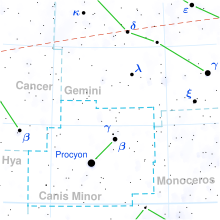Delta1 Canis Minoris
| Observation data Epoch J2000.0 Equinox J2000.0 (ICRS) | |
|---|---|
| Constellation | Canis Minor[1] |
| Right ascension | 07h 32m 05.949s[2] |
| Declination | +01° 54′ 52.13″[2] |
| Apparent magnitude (V) | +5.25[3] |
| Characteristics | |
| Evolutionary stage | Giant star or main sequence star |
| Spectral type | F0 III[4] or F0 V[5] |
| U−B color index | +0.20[3] |
| B−V color index | +0.22[3] |
| Astrometry | |
| Radial velocity (Rv) | +29.1±2.8[6] km/s |
| Proper motion (μ) | RA: −2.129 mas/yr[2] Dec.: −0.868 mas/yr[2] |
| Parallax (π) | 3.9896±0.0775 mas[2] |
| Distance | 820 ± 20 ly (251 ± 5 pc) |
| Absolute magnitude (MV) | −1.59[1] |
| Details | |
| Mass | 4.34±0.11[2] M☉ |
| Radius | 11.6±0.4[2] R☉ |
| Luminosity | 542+26 −22[2] L☉ |
| Surface gravity (log g) | 3.40±0.05[2] cgs |
| Temperature | 7,210+243 −86[2] K |
| Metallicity [Fe/H] | +0.15±0.05[7] dex |
| Rotational velocity (v sin i) | 50[8] km/s |
| Other designations | |
| δ1 CMi, 7 CMi, BD+02°1691, FK5 2587, GC 10085, HD 59881, HIP 36641, HR 2880, SAO 115581[9] | |
| Database references | |
| SIMBAD | data |
Delta1 Canis Minoris is a solitary,[10] yellow-white hued star in the constellation Canis Minor. Its name is a Bayer designation that is Latinized from δ1 Canis Minoris, and abbreviated Delta1 CMi or δ1 CMi. This star is faintly visible to the naked eye with an apparent visual magnitude of +5.25.[3] Based upon an annual parallax shift of 3.99 mas as seen from Earth,[2] this star is located roughly 820 light years from the Sun. It is drifting further away with a line of sight velocity of +29 km/s.[6]
Houk and Swift (1999) list a stellar classification of F0 V[5] for Delta1 Canis Minoris, indicating it is an F-type main-sequence star. However, Cowley et al. (1969) gave it a class of F0 III, which would suggest it is instead an evolved giant star.[4] The spectrum displays a higher than solar metallicity – a term indicating the abundance of elements other than hydrogen and helium compared to the Sun. The star is spinning with a projected rotational velocity of 50[8] km/s. Based on stellar models, it has 4.3 times the mass of the Sun and 11.6 times the Sun's radius. It is radiating 542 times the Sun's luminosity from its photosphere at an effective temperature of 7,210 K.[2]
References
[edit]- ^ a b Anderson, E.; Francis, Ch. (2012), "XHIP: An extended hipparcos compilation", Astronomy Letters, 38 (5): 331, arXiv:1108.4971, Bibcode:2012AstL...38..331A, doi:10.1134/S1063773712050015. XHIP record for this object at VizieR.
- ^ a b c d e f g h i j k Vallenari, A.; et al. (Gaia collaboration) (2023), "Gaia Data Release 3. Summary of the content and survey properties", Astronomy and Astrophysics, 674: A1, arXiv:2208.00211, Bibcode:2023A&A...674A...1G, doi:10.1051/0004-6361/202243940, S2CID 244398875. Gaia DR3 record for this source at VizieR.
- ^ a b c d Johnson, H. L.; et al. (1966), "UBVRIJKL photometry of the bright stars", Communications of the Lunar and Planetary Laboratory, 4 (99): 99, Bibcode:1966CoLPL...4...99J.
- ^ a b Cowley, A.; et al. (April 1969), "A study of the bright A stars. I. A catalogue of spectral classifications", Astronomical Journal, 74: 375–406, Bibcode:1969AJ.....74..375C, doi:10.1086/110819.
- ^ a b Houk, N.; Swift, C. (1999), "Michigan catalogue of two-dimensional spectral types for the HD Stars", Michigan Spectral Survey, 5, Bibcode:1999MSS...C05....0H.
- ^ a b de Bruijne, J. H. J.; Eilers, A.-C. (October 2012), "Radial velocities for the HIPPARCOS-Gaia Hundred-Thousand-Proper-Motion project", Astronomy & Astrophysics, 546: 14, arXiv:1208.3048, Bibcode:2012A&A...546A..61D, doi:10.1051/0004-6361/201219219, S2CID 59451347, A61.
- ^ Prugniel, Ph.; et al. (2011), "The atmospheric parameters and spectral interpolator for the MILES stars", Astronomy & Astrophysics, 531: 25, arXiv:1104.4952, Bibcode:2011A&A...531A.165P, doi:10.1051/0004-6361/201116769, S2CID 54940439, A165.
- ^ a b Jasniewicz, G.; et al. (July 2006), "Lithium abundances for early F stars: new observational constraints for the Li dilution", Astronomy and Astrophysics, 453 (2): 717–722, Bibcode:2006A&A...453..717J, doi:10.1051/0004-6361:20054421.
- ^ "del01 CMi", SIMBAD, Centre de données astronomiques de Strasbourg, retrieved 2017-09-03.
- ^ Eggleton, P. P.; Tokovinin, A. A. (September 2008), "A catalogue of multiplicity among bright stellar systems", Monthly Notices of the Royal Astronomical Society, 389 (2): 869–879, arXiv:0806.2878, Bibcode:2008MNRAS.389..869E, doi:10.1111/j.1365-2966.2008.13596.x, S2CID 14878976.
External links
[edit]- Kaler, Jim, "Eta and Delta-1 CMi", Stars, University of Illinois, retrieved 22 August 2012

